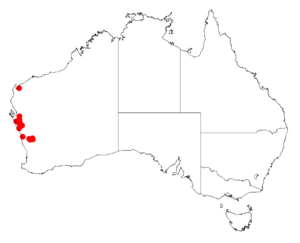Acacia hopperiana facts for kids
Quick facts for kids Acacia hopperiana |
|
|---|---|
| Scientific classification | |
| Genus: |
Acacia
|
| Species: |
hopperiana
|
 |
|
| Occurrence data from AVH | |
Acacia hopperiana is a type of small tree or shrub. It belongs to the Acacia family, also known as wattles. This plant is special because it is endemic to western Australia, meaning it only grows naturally in that part of the world.
Contents
What Acacia hopperiana Looks Like
This plant can grow as a small tree or a shrub. It usually reaches a height of about 0.6 to 4 meters (2 to 13 feet). It has smooth, grey bark.
Branches and Leaves
Acacia hopperiana often grows in a dense, bushy shape. Its branches are reddish-brown and smooth. They have fine, silvery lines running along them.
The leaves of this plant are not typical flat leaves. Instead, they are called phyllodes. These phyllodes are light green and have a pointed tip. They are usually 6 to 14 centimeters (2.4 to 5.5 inches) long and very thin, about 0.7 to 1 millimeter wide. They feel a bit stiff and can be straight or slightly curved. Each phyllode has ten thin lines running lengthwise.
Flowers and Seed Pods
Acacia hopperiana blooms in August. It produces bright yellow flowers. These flowers grow in simple spikes that are 10 to 25 millimeters (0.4 to 1 inch) long. The spikes are packed with many golden flowers.
After the flowers, seed pods start to form. These pods are thin but firm. They are 5 to 9 centimeters (2 to 3.5 inches) long and 2 to 3 millimeters wide. The pods are greyish-brown and flat. They are often slightly squeezed between each seed. The pods can be straight or gently curved.
Inside the pods, the seeds are arranged lengthwise. The seeds are shiny or spotted. They are small, about 2 to 3 millimeters long and 1.5 to 2 millimeters wide. Each seed has a small, white, cone-shaped part called an aril.
Where Acacia hopperiana Grows
This plant is native to a specific area in Western Australia. You can find it in the Mid West and northern Wheatbelt regions.
It grows in sandy areas, often in dense shrubland. It can be found on sandplains, in low areas between dunes (called swales), or on sand dunes themselves. Its growing areas are spread out, from Carnamah and Watheroo in the south, up to near Buntine Rock in the east, and a bit north of the Murchison River.
Related Plants
Acacia hopperiana is closely related to another plant called Acacia isoneura.
See Also

